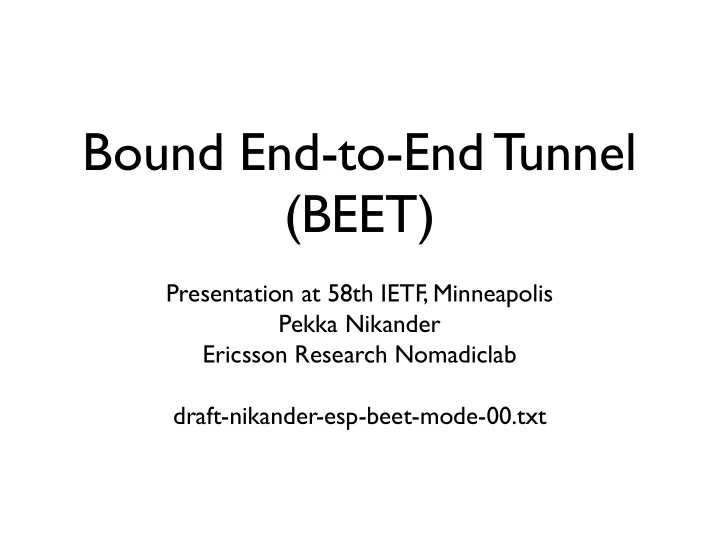

Bound End-to-End Tunnel (BEET) Presentation at 58th IETF, Minneapolis Pekka Nikander Ericsson Research Nomadiclab draft-nikander-esp-beet-mode-00.txt
Presentation outline • Background • BEET in a nutshell • Motivation • Answers to common objections • Summary 2
Background • mobike proposing mobility extensions to IKEv2 • nsrg, multi6, and hip discussing id/locator split • Separate end-point identifier and locator roles of IP addresses • Avoid transport protocol reconnection when underlying IP addresses change 3
BEET in a nutshell • Transport header but tunnel semantics • A fixed pair of inner addresses • Address ranges not allowed = Transport mode + Bellovin’s hostNAT BEET srci dsti payload srco dsto esp payload SA 4
Motivation 1: save bytes • “This is useless, just use tunnel mode!” • Counter-argument: sometimes bytes matter Headers Uncompressed ROCH Baseline: IPv4 + TCP 20 + 20 2 IPv4 + ESP + IPv4 + TCP 80 58 IPv4 + ESP + TCP 60 38 IPv6 + ESP + IPv6 + TCP 120 78 51% saving IPv6 + ESP + TCP 80 38 5
Motivation 2: Id/loc split • Inner addresses work as end-point identifiers • Visible to upper layer protocols • No change with mobility / multi-addressing • Outer addresses work as locators • Bound to the topological location • Change with mobility / multi-addressing • Difference to tunnel mode is architectural • Inner addresses internal, not visible on wire 6
Common objections (and answers to them) • “Adds complexity” • Does 98 lines of code really matter? • “Hard to add to existing implementations” • Make optional, use tunnel mode if not there • “Optional features are bad for portability” • Easy to check whether supported (PF_KEY) • “Not needed” • NAT traversal, HIP , multi6, ... 7
Summary • New mode to ESP • Tunnel semantics, inner and outer addresses • Fixed inner addresses, no address ranges • Transport mode header structure • PF_KEY support via SADB_IDENTTYPE • Up to 51% header savings when ROCH is used • Facilitates id/locator separation • Minimal added complexity: 98 lines of code 8
Recommend
More recommend